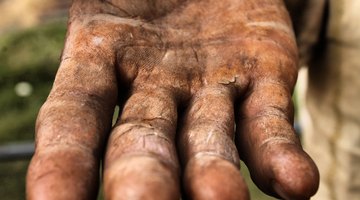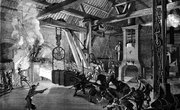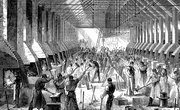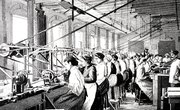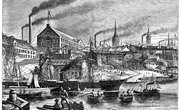Even though the early 1900s were a time when urbanization was growing like wildfire and cities were popping up all over the map, rural farming was still an important occupation of the working class. As factories and industries grew, farmers provided the food and agricultural resources that helped sustain life. The working class was often divided according to socioeconomic status with the wealthiest making up only a small percentage of the total labor force. Most of the working class struggled to make a decent living in factories, shipyards and farming communities.
Rural Farmers
Farmers didn’t enjoy the cosmopolitan aspects of the growing, populous, industrial cities but their workload was just as taxing. Rural workers performed hard labor to ensure their crops and livestock survived, despite droughts, famines and pestilence. Farming was often considered part of the lower socioeconomic class because farmers lived simple lives, without luxury, fame or prestige. However, rural workers didn’t face the poor working conditions, unsanitary housing environments, poor sunlight, smoggy air and disease-infested close quarters that many of the poorer city-dwellers encountered. The rural population remained a majority until 1920.
Factory Workers
The working class in industrialized cities consisted primarily of immigrant and native workers who labored at clothing factories, industrial plants and meat packaging facilities. Some also worked in lumberyards and shipyards that exported goods to other U.S. cities or across the Atlantic. Men, women and children worked in factories, often receiving pay that was incommensurate with their labor. In the early 1900s, labor unions petitioned for child labor laws, women’s workplace rights, better working conditions, fewer weekly work hours and higher pay, but it wasn’t until 1938 that the Fair Labor Standards Act was signed by President Franklin D. Roosevelt. By 1900, 30 million people, comprising 30 percent of the U.S. population, lived in cities, according to the Library of Congress.
Survival in the Lower Class
Even though the early 1900s are part of the Progressive Era, a majority of the working class didn’t experience the benefits of urban life. Many struggled to survive. The Library of Congress estimates that by 1904, one in three people living in the cities was close to starvation. Poor urban workers experienced overcrowded living conditions, dirty and poorly lit working conditions, insufficient clean water supplies, poor sewage methods and disease. The poor working class resided in slums and relied on low wages for basic survival. Many had a better standard of living as rural farmers in America or in their native homelands than in industrialized American cities.
Growing Middle Class
There was an increase in the middle class during the beginning of the 20th century. A surplus of jobs and increasing wages, especially for skilled workers and small business owners who specialized in particular trades, resulted in a growing middle class in urban areas. Experienced, skilled workers often held leadership roles in factories and industrial plants. The middle class enjoyed leisure, shopping, amusement parks, stadium sports, movies and recreation -- entertainment and resources that rural workers weren’t privy to. Department stores, restaurants and improved transportation systems made city life exciting and enjoyable for those in the working middle class who had disposable income to afford such luxuries.
Women in the Workplace
As women entered the workforce, dynamics of the working class changed. Women pursued college education, fair labor laws and increased political freedoms. Some women competed for jobs that had once been available only to male workers. New jobs in industrialized cities were especially appealing to single women who put off motherhood and marriage for independence and economic pursuits. As a result, the average family size dropped from seven children to four children from the 1800s to early 1900s.
Related Articles
References
Writer Bio
As curriculum developer and educator, Kristine Tucker has enjoyed the plethora of English assignments she's read (and graded!) over the years. Her experiences as vice-president of an energy consulting firm have given her the opportunity to explore business writing and HR. Tucker has a BA and holds Ohio teaching credentials.

